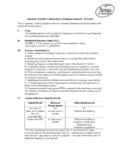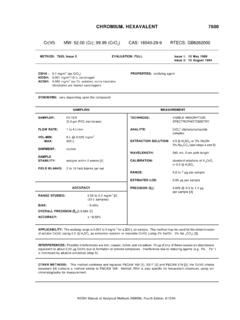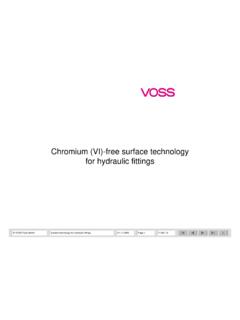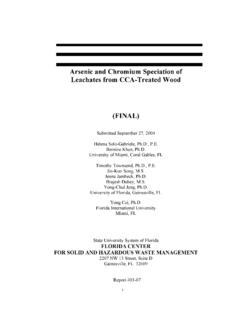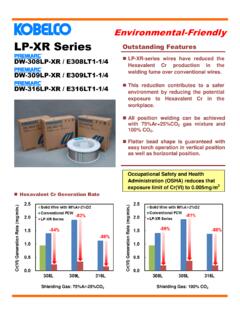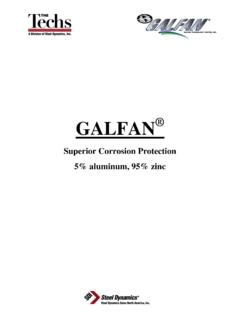Transcription of Sorption and mobility of chromium species in a …
1 2010 19th World Congress of Soil Science, Soil Solutions for a Changing World 1 6 August 2010, Brisbane, Australia. Published on DVD. 239 Sorption and mobility of chromium species in a range of soil types Girish ChoppalaA,B, Nanthi BolanA,B, Megharaj MallavarapuA,B and Zuliang ChenA,B A CRC+Contamination Assessment and Remediation of Environment (CRC CARE). Mawson Lakes, SA+5095. B CERAR, University of South Australia, Mawson Lakes, SA+5095; Abstract The adsorption of chromium species in soils has received much attention because of its toxicity to environment as adsorption controls the bioavailability.
2 Batch studies were performed to evaluate the effect of soil properties on the adsorption of Cr(III) and Cr(VI) in 12 different Australian soils, which varied in their origin, mineralogy, CEC and organic content. Soil properties, including pH, CEC, OM, clay, water extractable SO42+ and PO43+ were investigated on the adsorption of Cr(III) & Cr(VI). The adsorption data were fitted to Freundlich equation and the adsorption parameters, Kf and n were calculated.. In all soils, the amount of adsorption, as measured by Kf value was higher for Cr(III) than Cr(VI).
3 The amount of Cr(III) adsorbed increased with an increase in pH and CEC of soils. There was no significant effect of soil properties on the adsorption of Cr(VI) and its adsorption was high in soils with high iron content. The mobility of Cr species , as estimated by the retardation factor was higher for Cr(VI) than for Cr(III). Key Words Redox reactions, heavy metal, retardation, bioavailability, bulk density, remediation. Introduction In many countries, including Australia, tannery and timber treatment industries contribute a major source of effluents containing heavy metals including chromium (Cr).
4 The oxidation state of Cr in contaminated sites is an important indicator of toxicity. Hexavalent chromium (hex chrome) is highly toxic, carcinogenic, mutagenic and teratogenic. chromium is used as Cr(VI) in timber treatment and as Cr(III) in tannery industries (Barnhart 1997). The processes that control the environmental chemistry and fate of Cr include adsorption, redox transformations and precipitation reactions (Adriano 2001). While Cr(III) is strongly retained onto soil particles, Cr(VI) species such as chromate (CrO42+), bichromate (HCrO4+) and dichromate (Cr2O72+) are weakly sorbed to soils under alkaline to slightly acidic conditions, leading to their movement to sub surface environments (James and Bartlett 1983; Carey et al.)
5 1996). The maximum threshold level of Cr(VI) in water is mg/L (World Health Organization 1996). chromium (VI) is more stable form in equilibrium with atmospheric oxygen, but in the presence of soil organic matter it is reduced to Cr(III) (Cary et al. 1977; Grove et al. 1980; Bolan et al. 2003; Banks et al. 2006; Jiang et al. 2008). Oxidation+reduction (redox) reactions are largely controlled by the adsorption of Cr species in soils, the supply of redox compounds and microbial activity. The detoxification of Cr(VI) through reduction to Cr(III) and its subsequent adsorption has been considered as an effective method for remediation management of Cr contaminated soils.
6 The study of adsorption of Cr(VI) and Cr(III) is important in soils to understand the bioavailability of these two species . Despite the persistence of Cr contamination in soils, little data exist in the literature (Avudainayagam et al. 2001; Bolan and Thiagarajan. 2001) about the interaction of soil properties with Cr(III) and Cr(VI) in a range of Australian soils. The objectives of this research are to quantify the relative adsorption of Cr(III) and Cr(VI) and to examine the effect of soil properties on adsorption and mobility of these species in soils.
7 Materials and methods Soils Twelve different soils from 0+10 cm depth of representative profiles of soils in South Australia, Queensland and New South Wales were collected from uncontaminated land. The soil samples were analysed for pH, clay content, cation exchange capacity (CEC) (Gillman and Sumpter 1986), organic matter (Walkley and Black 1934) and water extractable SO42+ and PO43+ with 1:10 ratio of soil and solution by Ion chromatography (Dionex, ICS 2000+RFIC, Japan). The pH of the soils ranged from to and the organic matter ranged from to %.
8 2010 19th World Congress of Soil Science, Soil Solutions for a Changing World 1 6 August 2010, Brisbane, Australia. Published on DVD. 240 Batch Sorption A batch technique was used to perform all adsorption studies. Two gram of soil samples were taken in duplicates in 50 mL centrifuge tube, mixed with 20 mL of Cr solutions [Cr(NO3)3 for Cr(III) and K2Cr2O7 for Cr(VI)] at different concentrations (100, 200, 300, 400, 500 mg/L) and shaken on an end+over+end shaker at room temperature (22 C). After 16 hours of shaking, the soil suspensions were centrifuged, filtered through Nm filter and analysed for Cr by Inductively Coupled Plasma+Optical Emission Spectrophotometer (ICP+OES, Perkin Elmer, Optima 5300V, Japan).
9 The amount of Cr(III) and Cr(VI) sorbed by soils was calculated from (Eq 1): Cs= (Co+Ce) V / W (1) Where Cs is the amount sorbed (mg/kg), Co is the initial concentration (mg/L) and Ce is the equilibrium concentration (mg/L), V is the solution volume (L) and W is the weight of the air+dried soil sample (kg). Results and discussion Sorption isotherm The Sorption isotherms indicate the difference in Sorption between Cr(III) and Cr(VI). The Freundlich adsorption isotherm (Eq 2) was used to model Cr Sorption in 12 different soils: S = Kf Cn (2) where S is amount sorbed (mg/kg), C is equilibrium concentration (mg/L) and Kf & n are linear and exponential coefficients.
10 The Sorption of Cr, as measured by Kf values was higher for Cr(III) than for Cr(VI) . While Cr(III) adsorption increased with increasing pH (Figure 1a), the effect of pH on the Cr(VI) adsorption was not consistent (Figure 1b). The adsorption of Cr(III) increased with an increase in pH, which is attributed to cation exchange reactions of the hydrolysed species (Figure 2a ) (Grove et al. 1980). chromium (III) adsorption is generally influenced by pH and cation exchange capacity. When pH increases, negative surface charge of the soils increases, so there was an increased adsorption of Cr(III).

